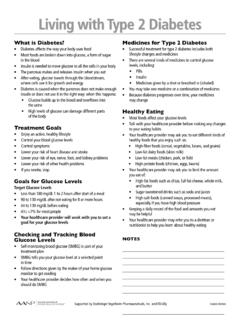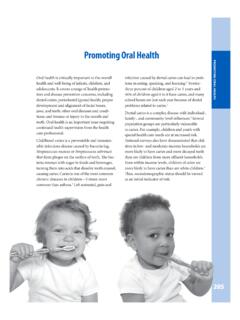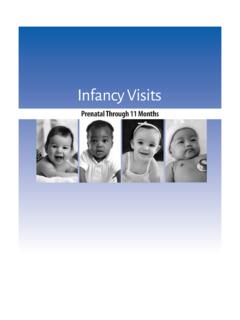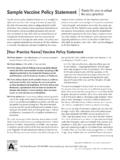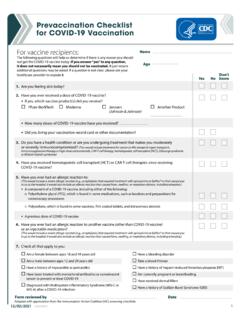Transcription of Standards of Practice - American Association of Nurse ...
1 I. QualificationsNurse practitioners (NPs) are licensed, independent practitioners who Practice autonomously and in coordination with health care professionals and other individuals. They provide primary and/or specialty nursing and medical care in ambulatory, acute, and long-term care settings. NPs are registered nurses with specialized, advanced education and clinical Practice competency to provide health care for diverse populations in a variety of primary care, acute, and long-term care settings. Master s, post-master s or doctoral preparation and national board certification is required for entry-level Practice (AANP, 2006).The Nurse practitioner role is consistent with the APRN consensus model practicing in the population foci of family, pediatrics, women s health, adult-geriatrics, neonatal, and psychiatric mental health. The scope of Practice is not setting specific but rather based on the needs of the patient (APRN Consensus Model, 2008).
2 Education, certification, and licensure of an individual must be congruent in terms of role and population foci. APRNs may specialize but they cannot be licensed solely within a specialty area. In addition, specialties can provide depth in one s Practice within the established population foci. Education and assessment strategies for specialty areas will be developed by the nursing profession, , nursing organizations and special interest groups. Education for a specialty can occur concurrently with APRN education required for licensure or through post-graduate education. Competence at the specialty level will not be assessed or regulated by boards of nursing but rather by the professional organizations (APRN Consensus Model, 2008).In addition to their clinical role, NPs may serve as health care researchers, interdisciplinary consultants, and patient advocates. NPs provide a wide range of health care services including the diagnosis and management of acute, chronic and complex health problems, health promotion, disease prevention, health education and counseling to individuals, families, groups and Process of CareThe Nurse practitioner blends the scientific process, current evidence and national Standards of care with a holistic approach to manage patient care and foster professional Practice .
3 This process includes the following Assessment of health Nurse practitioner assesses health status by: Obtaining a comprehensive relevant health, social and medical history. Performing a thorough physical examination based on age and history. Performing or ordering preventative and diagnostic procedures based on the patient s age and history. Identifying health risk factors. Evaluating social determinants of health that may influence the patient s health and Nurse practitioner makes a diagnosis by: Utilizing diagnostic reasoning. Synthesizing and analyzing the collected data from health history and any diagnostic information. Formulating a differential diagnosis(es) based on the history, physical examination and diagnostic test Development of a comprehensive plan of Nurse practitioner, together with the patient and family, establishes an evidence-based, mutually acceptable, cost-conscious, effective plan of care that maximizes health potential or end of life decisions.
4 Formulation of the plan of care includes:Discussion Paper: Standards OF Practice FOR Nurse PRACTITIONERSUSE OF TERMS SUCH AS MID-LEVEL PROVIDER AND PHYSICIAN EXTENDER Ordering and interpreting additional necessary diagnostic tests. Establishing priorities to meet the health care needs of the individual, family, and/or community. Prescribing or ordering appropriate necessary pharmacologic and non-pharmacologicinterventions. Developing a patient education plan considering the patient s health literacy competencies/learning needs. Ordering consultations or referrals based on evidence and Standards of professional care and shareddecisions with Implementation of the are based upon established priorities and consistent with the Nurse practitioner s specialized education and clinical Practice . Actions by Nurse practitioners are: Individualized, recognizing the patient s preferences and abilities. Consistent with the appropriate plan for care.
5 Based on scientific, evidenced based principles, theoretical knowledge, and clinical expertise. Inclusive of teaching and learning Follow-up and evaluation of the patient Nurse practitioner maintains a process for systematic follow-up by: Determining the effectiveness of the plan of care with documentation of patient care outcomes. Reassessing and modifying the plan with the patient and family as necessary to achieve health outcomes andpatient Care PrioritiesThe Nurse practitioner s Practice model emphasizes patient-centered holistic health care:A. Patient and family Nurse practitioner provides health and wellness education and utilizes community resource opportunities for the individual and/or Facilitation of shared decision making and participation of the patient/family in health care Nurse practitioner facilitates patient participation in health care by providing evidenced based, culturally sensitive information needed to make decisions and choices regarding: Promotion, maintenance, and restoration of health.
6 Appropriate utilization of health care resources. Potential for consultation with other appropriate health care Promotion of optimal Provision of continually competent Facilitation of entry into the healthcare The promotion of a safe Interprofessional and Collaborative ResponsibilitiesAs a licensed, autonomous practitioner, the Nurse practitioner contributes to patient care as a team leader and member in the provision of health care, interacting with professional colleagues to provide patient-centered comprehensive quality Paper: Standards OF Practice FOR Nurse PRACTITIONERSUSE OF TERMS SUCH AS MID-LEVEL PROVIDER AND PHYSICIAN EXTENDERV. Accurate Documentation of Patient Status and CareThe Nurse practitioner maintains accurate, legible, and confidential Responsibility as Patient AdvocateThe Nurse practitioner is a responsible advocate for patient welfare and upholds ethical and legal Standards . As an advocate, the Nurse practitioner influences health policy at the local, state, national, and international Quality Assurance and Continued CompetenceNurse practitioners recognize the importance of continued education through:A.
7 Participation in quality assurance review, including the systematic, periodic review of records and plans ofcare that may result in a quality improvement Maintenance of current evidence-based knowledge by completing continuing education activities related tothe Nurse practitioner s specialty and clinical Maintenance of certification and compliance with current state and federal Application of current evidence-based Practice and utilization of best Practice Integral Roles of Nurse PractitionersNurse practitioners combine the roles of provider, mentor, preceptor, educator, researcher, advocate, and interdisciplinary consultant. The Nurse practitioner interprets and emulates the role of the Nurse practitioner to individuals, families, professional colleagues, and Research as Basis for PracticeNurse practitioners support research and dissemination of evidence-based Practice by developing clinical research questions, conducting or participating in studies, implementing quality improvement, and incorporating system changes into Practice .
8 American Association of Nurse Practitioners, 1993 Revised 1998, 2002, 2007, 2010, 2013, 2015, 2019 Reviewed and revised by the AANP Fellows at the Winter 2015 MeetingDiscussion Paper: Standards OF Practice FOR Nurse PRACTITIONERS




